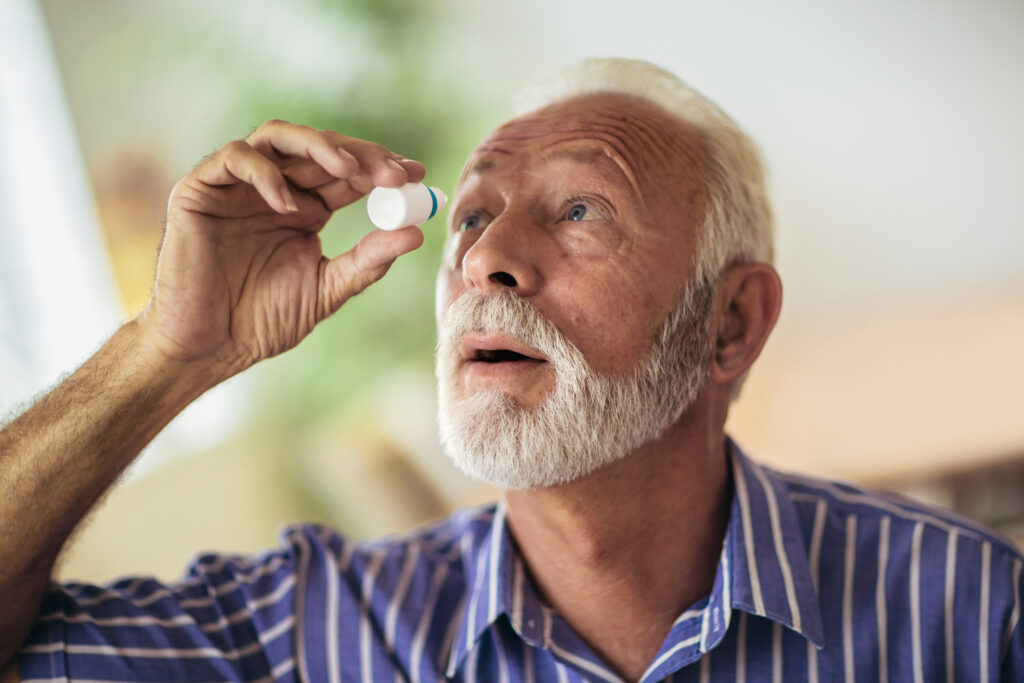
Most people with dry eye have a chronic condition that requires long-term treatment. New therapies can now help with the symptoms and underlying cause of the disease.
These include a new drug that increases tear production, and a thermal pulsation therapy that opens up the oil glands along your eyelids. Other options include plugging the tear ducts to reduce tear loss, which can be done either temporarily or permanently.
1. Over-the-Counter Eye Drops
If you have mild dry eye symptoms, try using nonprescription eye drops (also known as artificial tears) to lubricate your eyes. Typically, these come in liquid drops, gels or ointments that you apply to your eyelids several times a day. You may need to use them more often if you spend a lot of time at your computer or looking at electronic screens.
If your symptoms don’t improve with over-the-counter treatments, we can recommend prescription drops that increase tear production and decrease inflammation. One example is cyclosporine (Restasis) or lifitegrast (Xiidra) drops, which are used twice daily.
Another new option is scleral lenses, which are like contact lenses but cover the whole surface of your eye. These lenses help trap water on your eye, keeping it moist and reducing inflammation.
2. Meibomian Gland Expression
Meibomian gland dysfunction (MGD) stops the natural flow of oil from your eyes, causing the tear film to evaporate faster and leave your eyes feeling dry and uncomfortable. MGD symptoms often get worse during the summer and winter when you are indoors using the air conditioning or heating.
To diagnose MGD, your doctor will examine your eyelids with a microscope and may use an orange dye or lissamine green staining to check the color of your meibomian gland secretions. These lipids should be clear with minimal color and should not feel greasy, sticky or soapy.
Your doctor may recommend warm compresses to express your meibomian glands. You can use a washcloth with hot water or a heat mask from the drugstore. The heat helps soften the lipids and allows your meibomian glands to release more oil.
3. Punctal Plugs
Punctal plugs are tiny plugs that can be inserted into the puncta (the opening of the tear drainage duct in the corner of the eye). Occluding the puncta decreases the rate at which tears drain from the front of the eye, increasing the thickness of the tear film.
They can be inserted in the office with a very small amount of topical anesthesia. Most patients do not feel the plugs when they are in place. They may have a scratchy, slightly irritating sensation in the corner of the eyes at first, but this often goes away or is relieved by medications.
Punctal occlusion does not work for everyone and is most effective in people who have water deficiency caused by medications or age-related cicatricial changes to the lacrimal gland. Some doctors recommend trying temporary, dissolvable collagen plugs before moving on to permanent punctal occlusion.
4. Intense Pulsed Light (IPL) Therapy
While it may sound too good to be true, intense pulsed light (IPL) therapy is a pain-free treatment that relieves itchy, dry eyes. This procedure uses light-based energy to treat the underlying cause of itchy, red eyes—blepharitis and meibomian gland dysfunction (MGD).
Unlike standard treatments like artificial tears, warm compresses, and eyelid scrubs, IPL reduces inflammation by removing harmful mites and bacteria from the eyelashes and eyelid skin. It also heats the meibomian glands to liquefy oil and restore healthy gland function.
The Lumenis Optilight IPL device is placed over your eyes, and your doctor will administer a series of pulses of light. He or she may manually express the meibomian glands after the IPL treatment to start oil flow again. Four Optilight IPL treatments at 4-week intervals are typically necessary to achieve long-term relief from chronic dry eye syndrome.
5. Punctal Occlusion
Punctal Occlusion is a painless procedure that involves placing small plugs in the puncta of your eyes. These plugs stop tears from draining quickly and help to preserve your tear film on the ocular surface. This treatment can reduce dry eye symptoms and restore comfort and productivity.
The results of a recent clinical trial demonstrated that 85% of people with severe dry eye achieved significant symptomatic improvement after punctal cauterization. In addition, corneal fluorescein staining (an objective measure of dry eye disease) improved significantly in the punctal cauterization group compared with controls.
Punctal plugs are available as a temporary or permanent solution. Some complications of punctal occlusion can include epiphora (watery eyes), irritation from the plugs, silicone allergy (for temporary collagen plugs) or recanalization of the punctum after cauterization (for permanent plugs). These problems are rare and can be easily treated.

.jpg)